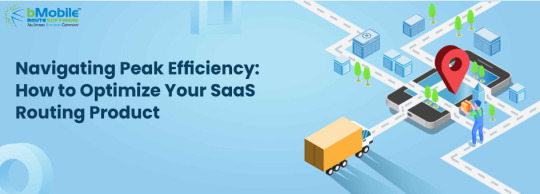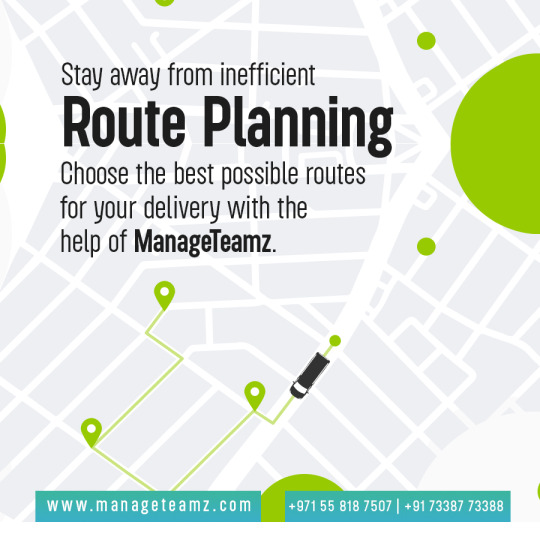#routeplanningsoftware
Text
How Field Sales Software Fuels Positive Sales Accountability

As sales people, we've all been there – juggling appointments, chasing leads, and trying not to misplace that crucial client's contact info. The life of an on-field sales rep is exhilarating, but let's face it, it can be chaotic. Enter field sales software – the unsung hero that not only streamlines your on-field operations but also builds a culture of positive sales accountability. Let’s explore how it does.
1. Real-Time Data at Your Fingertips
Gone are the days of deciphering messy spreadsheets or scribbling notes on the back of business cards. Field sales software ensures you have real-time access to critical data. Imagine walking into a client meeting armed with insights about their preferences, past interactions, and even the latest industry trends. It's like having a personal sales assistant whispering nuggets of wisdom in your ear.
2. Effortless Appointment Management
Let's be honest – keeping track of appointments can be a logistical nightmare. With field sales software, it's like having a magic wand that organizes your calendar seamlessly. The days of double-booking or forgetting about that crucial follow-up are long gone. The software sends you reminders, updates, and even suggests optimal routes to maximize your on-field efficiency. It's not just about making sales; it's about making the most out of your time on the road.
3. Lead Prioritization for Maximum Impact
Not all leads are created equal, and that's where field sales software shines. It helps you prioritize leads based on parameters like location, industry, and potential deal size. This smart sorting mechanism ensures you're not wasting time on leads that won't yield significant results. By focusing on high-priority leads, you're not just making sales; you're making strategic moves that impact the bottom line.
4. Accountability Through Activity Tracking

5. Seamless Communication for Team Synergy
In the world of on-field sales, communication is key. Field sales software acts as the glue that binds your team together, irrespective of geographical distances. It facilitates real-time communication, ensuring that everyone is on the same page. Need insights from a colleague who just cracked a similar deal? A few taps on the software, and you're connected. It's teamwork without the time zone constraints.
6. Adaptive Analytics for Informed Decision-Making

7. Enhanced Customer Relationships Through Personalization
In the era of personalization, generic sales pitches fall flat. Field sales software helps you tailor your approach by providing a 360-degree view of your customers. You know their history, preferences, and pain points. It's not just about selling a product; it's about building relationships. By understanding your customers on a personal level, you're not just a sales rep; you're a trusted advisor.
Field sales software isn't just a digital tool; it's a game-changer. It transforms the on-field sales experience by fostering positive accountability, streamlining operations, and enhancing customer relationships. So, fellow sales trailblazers, embrace the digital revolution and let field sales software be your partner in success. After all, in the world of sales, accountability isn't just a buzzword; it's the secret sauce for lasting success.
Our Software Service Applications:
Route Planning Software | Route Optimization Software | Mobile Order Taking Software | Field Sales Software | Online Scheduling Software | Delivery Management Software
#field sales software#bmobileroutesoftware#bmobile route software#routeaccountingsoftware#routeplanningsoftware#routeoptimization#bmobile#softwarecompany#route accounting software#trending#routeaccounting
0 notes
Photo

Merry Christmas! We appreciate your business and look forward to a mutually beneficial relationship. We look forward to serving you in the coming year IGSALabs,
The route optimization software that helps significantly reduce expenses and increase efficiency,
Plan Efficient Routes for Multiple Drivers - Start Your Free Trial Now! 👉-->
one-click delivery routing solutions for hundreds of stops In Secs. 15-30% cost savings
Increase your profits, Sign up for Free Trial Today!
#distributors#Wholesalers#retailers#manufacturers#DistributorsandWholeSalers#DISTRIBUTORSINDIA#routeplanningsolution#routeplanningsoftware
0 notes
Text
0 notes
Text
0 notes
Photo

Route optimization software - not only consider quickest, shortest and most direct routes with one click but also it considers others factors to get optimal routes. So, you can save money on transportation.
Share your business challenges with us and our team will guide to the optimal solution.
Schedule a meeting today
#eCommerce #solutions #lastmiledelivery #lastmilesolution #Logistics #business #deliverysolutions #Realtimetracking #routeoptimization #ovar #igsalabs #routeplanningsoftware #routeplan #routeplanning #routeplanningsoftware #routeoptimization #routeoptimizationsoftware #routeoptimisation #deliveryservice #fmcg #fmcgsoftware #deliverysoftware #deliverysoftwareforsmallbusiness
#route planning#route optimization#Route Planning Software#route#delivery software#eCommerce solutions lastmiledelivery lastmilesolution Logistics business deliverysolutions Realtimetracking routeoptimization ovar igsalabs
0 notes
Link
Prism Visual Software’s route planning software helps companies to reduce their business costs by saving fuel, reducing traffic violations, saving labor time, and enhancing field workforce security and safety.
#routeplanningsoftware
0 notes
Text
5 Reasons to Optimize Inventory Levels Based on Demand Forecasts

In the complex world of supply chain management, optimizing inventory levels stands as a pivotal maneuver. As businesses navigate the complexities of fluctuating demand, evolving consumer preferences, and dynamic market landscapes, leveraging demand forecasts to calibrate inventory levels emerges as a strategic imperative. Let's delve into five compelling reasons why aligning inventory optimization with demand forecasts is not merely beneficial but essential.
1. Minimizing Excess Inventory Costs

2. Enhancing Customer Satisfaction

3. Facilitating Agile Response to Market Dynamics
In today's volatile marketplace, agility isn't merely a buzzword; it's a necessity. Fluctuating consumer preferences, seasonal trends, and competitive pressures necessitate swift and informed decision-making. By aligning inventory optimization with demand forecasts, businesses can proactively respond to market dynamics, capitalize on emerging opportunities, and mitigate risks. This strategic alignment fosters resilience, adaptability, and competitive advantage in an ever-evolving landscape.
4. Optimizing Working Capital Efficiency
Working capital – the financial lifeblood of organizations – warrants meticulous stewardship. Tying up capital in excessive inventory detracts from liquidity, hampers investment capacity, and imposes opportunity costs. By aligning inventory levels with demand forecasts, businesses can optimize working capital efficiency, enhance liquidity, and allocate resources judiciously across strategic initiatives. This financial prudence empowers organizations to navigate economic cycles, capitalize on growth opportunities, and drive sustainable profitability.
5. Fostering Collaborative Supply Chain Relationships
Supply chain management transcends organizational boundaries, encompassing suppliers, distributors, and logistics partners. By leveraging demand forecasts to optimize inventory levels, businesses can foster collaborative relationships, enhance supply chain visibility, and facilitate seamless coordination across stakeholders. This collaborative ethos cultivates trust, enhances operational efficiency, and paves the way for innovation, responsiveness, and mutual growth.
A Strategic Imperative for Modern Businesses
In summary, optimizing inventory levels based on demand forecasts is not merely a tactical endeavor; it's a strategic imperative for modern businesses. By minimizing excess inventory costs, enhancing customer satisfaction, facilitating agile response to market dynamics, optimizing working capital efficiency, and fostering collaborative supply chain relationships, businesses can navigate complexities, capitalize on opportunities, and drive sustainable growth.
As we navigate the intricacies of today's global marketplace, embracing demand-driven inventory optimization transcends operational excellence; it embodies a commitment to innovation, customer-centricity, and strategic foresight. So, let's harness the power of demand forecasts, optimize inventory levels judiciously, and chart a course for success in an ever-evolving landscape. After all, in the realm of supply chain management, foresight, agility, and collaboration reign supreme.
Our Software Applications:
Inventory Management Software | Truck Inventory Software | Multi Warehouse Management Software | Fleet Management Software
#bmobileroutesoftware#routeplanningsoftware#inventory software#inventory management#routeaccountingsoftware#bmobile route software#routeoptimization#trending post#united states of america
0 notes
Text
How to improve warehouse efficiency?

Statistics say that warehouse employees undertake some form of dangerous activity. A staggering 20,000 workers get injured in accidents while handling forklifts alone. What do these figures point out? Inefficient warehouse operations are executed through poorly maintained equipment, cluttered floor layouts, and the absence of standardized processes and procedures. The result is that workers spend most of their time sorting through the items, cleaning the mess, and falling short of being productive. Three things are critical for warehouses to operate with maximum efficiency: neatly organized floor layouts, optimized workflows, the adoption of technology, and automated processes. Before we list ways and means to improve warehouse efficiency, let's quickly read how warehouses benefit from staying efficient.
Here are some of the benefits of a highly efficient warehouse:
Sharp increase in profits - By automating and trimming down specific steps in the day-to-day process, you see an increase in productivity, reduced downtime, and improved profits.
Happy Workers - Workers complete the tasks efficiently without confusion or struggle and contribute confidently.
Happy Customers - A warehouse with accurate inventory tracking never runs out of stock and meets customers’ needs on time. Thus, an efficient warehouse wins customer loyalty and attracts repeat orders.
Streamlined Operations - When the warehouse is organized correctly, it becomes easy for workers to process the orders in quick succession, also taking the utmost care of the goods from damage. No chaos!
By now, you should have understood the significance of running an efficient warehouse and how you benefit from it. But how you get to that stage is something that you will be reading below.
You would have emphasized warehouse productivity to your team several times. It is not hard-to-achieve unless the top leadership equips workers with the tools or drivers needed to stay productive.
Here we outline 7 ways to improve warehouse efficiency
1. Accurate Inventory Tracking
One of the pressing issues warehouses face is overstocking and understocking. You can tackle it only by incorporating a foolproof inventory tracking system on the floor. Stock trackers on the floor must be given proper inventory tracking devices to identify excess stock, remove it and allocate space for on-demand inventory based on customer demands. On the other hand, poor tracking means items go off the shelf without a record.
When the inventory tracked is accurate, you can plan your future orders and keep fulfilling them by ensuring supplies are in stock.
2. Organize the layout
Have a well-planned layout for the floor space. Make the navigation easier for your workers with clearly earmarked areas dedicated to different processes. A clutter-free pathway also means that your equipment has less wear and tear. It is better to have the picking path on one end of the floor space that systematically leads to the area dedicated to wrapping the items. Give ample space between workstations so that you reduce unnecessary crossover and chaos. Integrate the workstation with communication tools to ensure hassle-free communication.
3. Hear from Employees
There’s no better person than your employees to provide valuable feedback on productivity improvements. Figure out what is letting them down and what can inspire them to do more. Get their insights on improving warehouse efficiency as they know the pros and cons of the existing warehouse management system. This exercise keeps your employees motivated as they get the impression that their views are heard in the warehouse. From the management perspective, the objective of such an activity is to zero in on the shortcomings and address other productivity-slowing factors.
4. Impart Proper Training
Training and cross-training your warehouse workers are essential to achieving high productivity levels. Be it managers, supervisors, or forklift drivers, everybody in the work ecosystem must be trained to complete their jobs on time and in a safe manner. Most importantly, floor supervisors must know how to manage the workers assigned to them for different activities. Foster a culture that encourages workers to ask questions and clarify their doubts then and there.
Cross-training the team to undertake different tasks is essential in a warehouse management setup. The benefit of cross-training is that instead of entirely relying on one resource for a particular job, you can have a set of employees ready to take up the same job in the absence of the original resource.
5. Keep a tab on Performance
Regarding warehouse management, there are four key performance indicators (KPIs) that shed light on the efficiency of warehouse operations. The question of how to improve warehouse management depends on how the warehouse has fared in these metrics. They are
Accuracy of inventory
Efficiency in picking and packing
Time taken to fulfil orders
Time taken to unload, check and organize inventory
Tracking these indicators will help you identify the areas that need attention, monitor the progress of various processes, and see if productivity goals are met. Make sure all key stakeholders (including employees) have access to these metrics, so they can get a first-hand account of where overall productivity stands. Pay them monthly or weekly bonuses to make them do better and keep them motivated.
6. Keep your warehouse equipment in proper shape
Remember that all warehouse equipment, like forklifts, lift trucks, etc., needs regular maintenance. Poorly maintained equipment increases the risk of untoward incidents and injuries on the floor. Equipment failure results in unnecessary downtime. Even a minute of downtime can cost the management thousands of dollars. Instead, you can invest in periodic maintenance and ensure the equipment is up and running and available for your workers all the time.
Therefore, to improve warehouse efficiency, management must introduce operational changes, adopt technology into its day-to-day functioning, and invest in safety measures. The combined outcome of all these efforts can be noticed in increased productivity, better asset management, proper inventory tracking, and more cost-effective deliveries.
Explore bMobile’s warehouse management solution and contact us at +1 (888) 900-5667 for more details.
Our Software Services:
Quotation Software | Sales Order Management Software | Purchase Order Management Software | Invoicing Software | Pick Pack Ship Software | Payment Processing Software
#bmobileroutesoftware#routeplanningsoftware#routeaccountingsoftware#trending#google#wikipedia#softwarecompany#tcs#market trends#marketshare#news18
0 notes
Text
Navigating Peak Efficiency: How to Optimize Your SaaS Routing Product

In the world of SaaS, efficiency is everything. The faster and more accurately you can deliver your product, the more likely you are to attract and retain customers. This is especially true when it comes to routing, which is a critical component of many SaaS products. Routing refers to the process of directing data or requests from one point to another, whether it's a user request or a data packet.
The importance of routing optimization cannot be overstated. By optimizing your routing, you can reduce latency, improve reliability, and enhance the overall user experience. This, in turn, can lead to increased customer satisfaction, higher retention rates, and ultimately, greater revenue. But achieving peak efficiency is not always easy. It requires a combination of data analysis, strategic planning, and the right tools and software.
Key components of SaaS routing optimization
Before we dive into the specifics of routing optimization, it's important to understand some of the key components that make up this process. These include:
Load balancing
Load balancing involves distributing traffic across multiple servers or data centers in order to optimize performance and reduce downtime. This is especially important for SaaS products that experience high levels of traffic or have users distributed across different geographic regions.
Traffic shaping
Traffic shaping involves prioritizing certain types of traffic over others. This can help to ensure that critical traffic, such as user requests, are given priority over non-essential traffic, such as background updates.
Redundancy
Redundancy involves creating backups of critical systems or data in order to minimize downtime in the event of a failure. This is especially important for SaaS products that cannot afford to experience extended periods of downtime.
Security
Security is a critical component of any SaaS product, and routing optimization is no exception. By implementing secure routing practices, you can help to protect your users' data and prevent unauthorized access.
Analyzing data for optimization
Data analysis is a critical part of any optimization process, and routing optimization is no exception. By analyzing data related to your routing performance, you can identify areas for improvement and make data-driven decisions about how to optimize your routing.
There are several key metrics that you should be tracking in order to analyze your routing performance. These include:
Latency
Latency refers to the amount of time it takes for a user request to be processed and returned. By tracking latency, you can identify bottlenecks in your routing process and make improvements to reduce latency.
Error rates
Error rates refer to the percentage of user requests that result in errors or failures. By tracking error rates, you can identify patterns and make improvements to reduce the number of errors.
Traffic patterns
Traffic patterns refer to the volume and distribution of traffic across your routing infrastructure. By analyzing traffic patterns, you can identify areas of congestion or under-utilization and make adjustments to optimize your routing.
Tips for optimizing SaaS routing
Now that we've covered some of the key components of routing optimization and the importance of data analysis, let's dive into some specific tips and strategies for optimizing your SaaS routing product.
Analyze usage patterns: Use analytics tools to monitor how users are interacting with your product. Look for patterns in usage and identify areas where users are experiencing bottlenecks or inefficiencies.
Optimize for speed: Routing can be a time-sensitive process, so it's important to optimize your product for speed. This could involve using faster algorithms, optimizing your code for performance, or using caching to reduce response times.
Prioritize reliability: Customers rely on routing products to be available when they need them, so it's essential to prioritize reliability. This could involve implementing failover systems, using load balancers to distribute traffic, or implementing backup systems to ensure that your product remains available in the event of an outage.
Improve scalability: As your user base grows, your product needs to be able to handle increased demand. Make sure your product is designed to scale, whether that means implementing horizontal scaling, using cloud-based infrastructure, or using containerization to isolate services.
Automate where possible: Automating routine tasks can free up your team's time and reduce the risk of human error. Consider automating processes like testing, deployment, and monitoring to improve efficiency and reduce the risk of downtime.
Implement security measures: Routing products can be vulnerable to attacks, so it's important to implement security measures to protect your users' data. This could involve implementing SSL/TLS encryption, using firewalls to block unauthorized access, or implementing multi-factor authentication to reduce the risk of credential theft.
Measuring success: Key metrics to track
As we've discussed, data analysis is a critical part of optimization. But how do you know if your optimization efforts are working? There are several key metrics that you should be tracking in order to measure the success of your routing optimization efforts. These include:
Latency
Reducing latency is one of the primary goals of routing optimization, so this is a key metric to track. Make sure that you are monitoring latency on an ongoing basis and making adjustments as needed to improve performance.
Error rates
Tracking error rates can help you to identify patterns and make improvements to reduce the number of errors and failures in your routing infrastructure.
User satisfaction
Ultimately, the success of your routing optimization efforts will be reflected in user satisfaction. Make sure that you are monitoring user feedback and using this feedback to drive your optimization efforts.
Optimizing your SaaS routing product is a critical part of achieving peak efficiency and delivering a high-quality user experience. By following the tips and strategies we've covered in this guide, you can streamline your operations and maximize your productivity.
Our Software Applications:
Order Management Software | Route Accounting Software | Inventory Management Software | Point of Sale Software | Fleet Management Software
0 notes
Text
youtube
Our Software Applications:
Order Management Software | Route Accounting Software | Inventory Management Software | Point of Sale Software | Fleet Management Software
#bmobileroutesoftware#routeaccountingsoftware#routeoptimization#routeaccounting#routeplanningsoftware#Youtube
0 notes
Text
Ace your delivery game:Expert tips for a smarter delivery performance
Have you been finding it tough to hit the high notes when it comes to your delivery performance? You're not alone. As delivery performance metrics become increasingly important, more and more companies are struggling to keep up.
But don't worry, there's hope! Whether you're just starting out or you've been in the game for a while, there are practical tips and tricks you can use to get your delivery performance metrics right. In this article, we'll take a deep dive into the world of expert tips for improving metrics—from setting realistic goals to understanding how THEY influence YOUR performance.
Understanding the Basics of Delivery Performance Metrics
To get a better sense of how your delivery performance is doing, take a look at some key metrics. Here are a few to consider:
On-time Delivery Rate: measures how often orders arrive on time.
Delivery Accuracy: gauges how often orders are correct and complete.
First Time Right (FTL): gives insight into the success rate of getting orders right on the first attempt.
Package Damage Rate: measures the number of damaged packages due to mismanagement or mishandling.
Having a good grasp on these fundamental metrics will help you track your progress and identify areas for improvement.
Analyzing Delivery Performance Data
Ready to rock your delivery performance? The best way to do that is by analyzing your performance data. Here's how: Start by looking at the big picture—your overall performance metrics. Are they going up or down? How have they changed over time?
Once you have an overview of your overall performance, drill down into the data and identify areas for improvement. What specific opportunities can you identify that are impacting your delivery times? This can be anything from route optimization, staff scheduling, vehicle maintenance, or even traffic signals and speed limits.
You can also review customer satisfaction metrics such as delivery accuracy, on-time delivery rates, and customer feedback scores. Evaluate each of these and look for trends in customer expectations—and then use this knowledge to improve your service offerings.
Finally, analyze key performance indicators (KPIs) such as miles per gallon, fuel efficiency and total service costs. Analyzing these KPIs will help you better understand the financial implications of optimizing your delivery operations and will ultimately help you improve your bottom line.
Automating and Optimizing Delivery Processes
If you want to take your delivery performance to the next level, it's time to start automating and optimizing your processes where possible. This could mean using delivery management software, or simply streamlining existing processes with technology. Here are a few tips to get you started:
Utilize Technology
Take advantage of the latest technology solutions to simplify your delivery operations. Using technology not only reduces manual labour but also keeps all parts of the delivery process organized and on-schedule for faster and smoother deliveries.
Monitor Delivery Paths
Monitor delivery paths in near real-time and make sure your drivers take the most efficient, cost-effective routes for each trip. This helps reduce fuel expenses and improves on-time performance metrics.
Improve Communication
Make sure everyone involved in the delivery process is on the same page. Use communication tools such as text messaging, two-way radio handsets, or mobile apps that let drivers and dispatchers stay in constant communication during each job. Automated solutions can also track driver locations in real time, so you can provide accurate ETAs and improve customer satisfaction rates.
The right combination of automation technologies can help you improve overall efficiency, reduce costs, increase customer satisfaction levels and save time for all stakeholders involved in the delivery process.
Implementing a Delivery Management Solution
If you're ready to take your delivery performance to the next level, consider implementing a delivery management solution. This is essentially a software tool that can help you keep track of where your parcels are and ensure they reach their destination on time.
A delivery management solution can do much more than just track shipments, though. You can use it to:
Automate shipment processes - set up automatic emails, route tracking, and more.
Monitor driver performance - set standards for driver performance and receive alerts when these standards are not met.
Analyze data - compile real-time insights into driver performance, identify potential problems before they arise, and more.
Using a delivery management solution can help you save both time and money in the long run, by ensuring that all your shipments get delivered on-time and increasing efficiency throughout the supply chain. Plus, it's an effective way to stay informed about each step of the delivery process and give customers peace of mind when ordering from you.
Managing Inventory Levels Wisely
Keeping a close eye on inventory levels is key to increasing delivery performance. With the right inventory levels, you can avoid costly delays caused by low stock and make sure orders are fulfilled in a timely manner.
Know Your Numbers
The first step to managing your inventory wisely is to know your numbers. Regularly assess the number of items in stock, the rate of sale, ordering cycle and peak seasons. Analyzing this data can help you find trends and determine the right balance of products to carry at any given time.
Set Reorder Points
Choose an appropriate reorder point that allows for sufficient back ups for peak seasons or unexpected surges in demand. It’s also important to take into account lead times—the time it takes for an order to be processed and delivered from a supplier—so that you don’t run short on inventory unexpectedly.
By carefully monitoring your current inventory levels and understanding your customers’ needs, you can make sure you maintain enough stock so that orders can be quickly processed and delivered at a moment’s notice. This will help get those deliveries out quickly and meet customer expectations for fast service.
Using Real-Time Tracking to Improve Efficiency
Have you ever had to guess where your delivery fleet is and when the shipments will arrive? That's what real-time tracking can help you with! With this technology, you can accurately track your deliveries in real-time and make smarter decisions about delivery schedules.
Here are some ways real-time tracking can help improve your delivery performance metrics:
Cut down on driver idle time
Real-time data helps you adjust routes to eliminate unnecessary stops, which in turn reduces overall driver idle time. This gives you the ability to optimize routes and give customers accurate estimated arrival times.
Reduce unauthorized stops
By accurately tracking the location of your drivers and shipments in real-time, you can reduce any unauthorized stops that may be dragging down delivery performance metrics. Keeping close tabs on deliveries in transit helps keep drivers accountable and prevent delays.
Improve customer experience
With accurate ETAs and improved responsiveness, you’ll be able to offer better customer service. Real-time tracking gives customers visibility into their shipments and a sense of control over their deliveries, allowing them to plan ahead and even request routing changes if needed.
Conclusion
The key takeaways for improving delivery performance are simple: measure your performance metrics, focus on KPIs, and invest in the right tools to make delivery work smoother. Using technology to streamline processes, track real-time delivery performance data, and automate processes will give you the insight and control you need to reduce delays and make sure deliveries are successful.
This knowledge, combined with the right attitude, will help you give your customers the experience they expect while increasing your efficiency and profitability. Implementing these expert tips into your delivery performance strategy will make your delivery operations more effective and give you a competitive edge.
Route Planning Software | Route Optimization Software | Online Scheduling Software | Delivery Management Software
#routeaccountingsoftware#routeplanningsoftware#routeoptimization#routeaccounting#bmobileroutesoftware#bMobile
0 notes
Text
Expert advice on how to improve your delivery performance
Have you been having difficulty hitting the high notes in your delivery performance? You’re not by yourself. As delivery performance measures grow more critical, an increasing number of businesses are failing to stay up.
But don’t despair, there is yet hope! There are practical ideas and methods you can utilise to get your delivery performance metrics perfect, whether you’re just starting out or have been in the business for a long. In this post, we’ll delve deep into the world of professional suggestions for increasing metrics, covering everything from setting realistic objectives to understanding how THEY affect YOUR performance.
Have you been having difficulty hitting the high notes in your delivery performance? You’re not by yourself. As delivery performance measures grow more critical, an increasing number of businesses are failing to stay up.
But don’t despair, there is yet hope! There are practical ideas and methods you can utilise to get your delivery performance metrics perfect, whether you’re just starting out or have been in the business for a long. In this post, we’ll delve deep into the world of professional suggestions for increasing metrics, covering everything from setting realistic objectives to understanding how THEY affect YOUR performance.
Data Analysis for Delivery Performance
Are you ready to up your delivery game? The easiest method to accomplish this is to examine your performance statistics. Here’s how it’s done: Begin with the big picture — your overall performance measures. Are they rising or falling? What has happened to them throughout time?
Drill down into the data to uncover areas for improvement once you have an overview of your overall performance. What particular possibilities do you see that are influencing your delivery times? This might include everything from route optimisation to personnel scheduling to vehicle maintenance to traffic lights and speed restrictions.
Automating and Improving Delivery Procedures
If you want to improve your delivery performance, start automating and optimising your procedures wherever feasible. This might suggest employing delivery management software or simply leveraging technology to streamline existing operations. Here are some pointers to get you started:
Make Use of Technology
Utilise cutting-edge technologies to streamline your delivery processes. Using technology not only eliminates physical effort, but it also maintains all aspects of the delivery process organised and on time, resulting in quicker and smoother deliveries.
Track Delivery Routes
Monitor delivery routes in near real time to ensure your drivers use the most efficient and cost-effective routes for each trip. This lowers gasoline costs and increases on-time performance indicators.
Enhance Communication
Ascertain that all parties participating in the delivery process are on the same page. Use communication options like text messaging, two-way radio handsets, or mobile applications to keep drivers and dispatchers in continual contact during each assignment. Automated systems may also track driver positions in real time, allowing you to deliver precise ETAs and increase client satisfaction.
The appropriate combination of automation technologies may assist you in improving overall efficiency, lowering costs, increasing customer satisfaction, and saving time for all stakeholders engaged in the delivery process.
Putting a Delivery Management System in Place
Consider using a delivery management solution if you’re ready to take your delivery performance to the next level. This is simply a software programme that may help you keep track of your deliveries and guarantee they arrive on time.
Understand Your Numbers
Knowing your numbers is the first step towards good inventory management. Assess the quantity of products in stock, the pace of sale, the ordering cycle, and peak seasons on a regular basis. Analysing this data can assist you in identifying trends and determining the best product balance to carry at any particular moment.
Establish Reorder Points
Select a reorder point that provides for enough back-ups during peak seasons or unforeseen increases in demand. It’s also critical to consider lead times — the amount of time it takes for an order to be processed and delivered from a supplier — so you don’t run out of inventory abruptly.
Our Software Applications:
Best Quotation Software | Sales Order Management Software | Purchase Order Management Software | Best Invoicing Software | Payment Processing Software
#routeplanningsoftware#routeaccountingsoftware#routeaccounting#bmobileroutesoftware#routeoptimization
1 note
·
View note
Text
Advance Happy New Year 2020
We appreciate your business and look forward to a mutually beneficial relationship. We look forward to serving you in the coming year
IGSA Labs
With 12 years of experience of developing and implementing supply chain solutions,
IGSA Labs introduce/update - advanced solution ORDER VEHICLE ASSIGNMENT & ROUTE PLANNING(OVAR)- route planning solution web-based application,
Improve operational efficiency through better route scheduling, Reduce
unauthorized vehicle usage, Track total costs, cost-per-mile, and Vehicle utilization
Advantage of using of OVAR
Route planning with minimum cost, maximum vehicle utilization and on-time customer serviceability.
Order-vehicle assignments, multi-drop milk-run dispatches and direct delivery dispatches based on mathematical optimization.
Considers multiple customer orders, locations, vehicles, multiple cost structures, distances, travel times, fuel consumption, capacities, serviceability and MOQ constraints.
Real-time tracking and communication to supplier and customers.
Easy-to-use interface with maps and dashboards.
Works on Smartphone or computer, Easy to subscribe, learn and operate.
Save your business time and money? Start your Free 15-day Trial Today.
#DISTRIBUTORSINDIA #routeplanning #routeplan #fleet #transportationcost #save #gps #googlemaps
#distributors#routeplanningsoftware#routeplanningsolution#wholesalers#retailers#Manufacturers#distributorsandwholesalers#FMCG
0 notes
Photo

Stay away from inefficient route planning. Choose the best possible routes for your delivery with the help of #ManageTeamz.
Signup now: https://bit.ly/36g7kQo
#RoutePlanningSoftware #AutoAllocation #RoutingOptimization #DeliveryBusiness #DeliveryAutomation #DeliverySoftware
0 notes
Photo

Move away from the inefficient manual route planning. Go with automated routing algorithms to save time and reduce delivery costs.
Signup now: https://bit.ly/37TFA5y
#RoutePlanningSoftware #AutomaticScheduling #RouteOptimizationSoftware #ManageTeamz
0 notes
Photo

We know the time importance. ManageTeamz is giving a most efficient route to deliver all your orders on time.Try now for free: https://bit.ly/36lNgg6
#RouteOptimization #RouteOptimizationSoftware #RoutePlanner #RoutePlanningSoftware #DeliverySoftware
0 notes